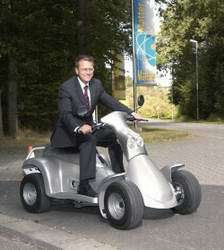From the Laboratory to the Road: Clean Driving with Fuel Cells

This nippy little four-wheel vehicle has an interesting inner life: and that is meant quite literally! Scientists from Research Centre Jülich have equipped a commercial electric vehicle with a fuel cell that drives the conveyance via an electric motor. The chief attraction: the fuel cell used is a direct methanol fuel cell (DMFC), which – in contrast to many other types of fuel cell – does not use gaseous hydrogen, but rather converts liquid methanol into electricity. The advantage is quite obvious - liquid methanol is easier to handle and store than gaseous hydrogen; you can fill up the vehicle in the normal manner.
"The grand challenge consisted in designing the overall system comprising the fuel cell and all the components necessary for operation in such a way that it fitted in a vehicle. The vehicle itself should not have any major external modifications – and this is exactly what we have done", Professor Detlef Stolten, head of the Institute for Energy Process Engineering (IWV-3) describes his team's achievements. "This engineering is an indispensable part of modern fuel cell research."
Getting the electromobile with a fuel cell drive system on the road was only possible through a real team effort by several working groups within IWV-3 and the Central Technology Division (ZAT). Instead of three conventional lead-acid batteries, as installed by the manufacturer, the vehicle is now powered by a hybrid drive consisting of a fuel cell and a lithium-ion battery. In normal operation, the fuel cell drives the vehicle's electric motor. The battery is called upon in cases of special load such as when starting or driving uphill. The fuel cell then continuously recharges the battery. With a full tank, the vehicle has about twice as great a range amounting to an estimated 120 kilometres and, moreover, there is no need to "fill it up" at an electric socket. The vehicle is ready for use at any time.
This project required a great deal of detailed development work. Thus, for example, the installed fuel cell stack has a power of 1.3 kilowatts and consists of 100 single cells. The central component of each cell is the membrane electrode assembly (MEA). Such MEAs are now produced mechanically at IWV-3 and no longer by hand. In this way, the scientists can continue to improve manufacturing techniques for fuel cells and fabricate high-quality components in a near-industrial and low-cost process.
The fuel cell electrodes contain platinum as the catalyst. On the one hand, this noble metal facilitates the chemical reaction that produces electricity, but on the other hand it is very expensive. The researchers have succeeded in using platinum very sparingly in the electrodes thus reducing the quantity required to less than half that needed for the previous state of the art. Furthermore, they used a special graphite for the cell components instead of metallic materials. This means the stack is lighter and cheaper. Finally, many functions – such as the methanol supply – have been integrated into the stack. The new design is space-saving and has "consequences" for the surrounding system components. It is, for example, no longer necessary to preheat or humidify the air, which is the methanol's reactant. Altogether, the scientists have "shrunk" the whole system by a factor of three to four to make it fit into the electric vehicle.
The Jülich demonstration vehicle has successfully completed its first road trials. It is now being put through its paces. And it is going on tour in October. At the "Fuel Cell Seminar 2004" in San Antonio, Texas, the electromobile will be presented to about 2000 conference delegates at the beginning of November. "With our demonstration vehicle we also intend to seek potential industrial partners with whom we can continue to jointly develop the system," says Detlef Stolten looking further into the future.
The Science Minister of North Rhine-Westphalia, Hannelore Kraft, was very pleased with the success of the Jülich scientists: "Fuel cells have convincing properties as future energy converters. They are extremely clean, environmentally friendly, efficient, and everybody is now talking about them for use in road vehicles, laptops and small power plants. With the "JuMOVe" electric vehicle, the Jülich scientists have demonstrated a possible application for fuel cells in the mobile sector." The Ministry for Science and Research in NRW has supported the development of fuel cell technology at Research Centre Jülich in the past four years to the tune of € 1.5 million.
Source: Forschungszentrum Juelich















